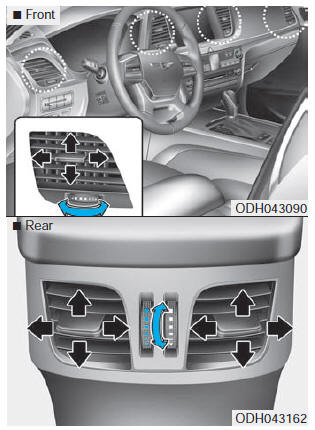Hyundai Genesis: Manual heating and air conditioning / Mode selection
.jpg)
The mode selection button controls the direction of the air flow through the ventilation system.
The air flow outlet port is converted as follows:
.gif)
.jpg)
Air flow is directed toward the upper body and face. Additionally, each outlet can be controlled to direct the air discharged from the outlet.
.jpg)
Air flow is directed towards the face and the floor.
.jpg)
Most of the air flow is directed to the floor and the windshield with a small amount directed to the side window defrosters.
.jpg)
Most of the air flow is directed to the floor, with a small amount of the air being directed to the windshield and side window defrosters.
Defrost-Level (A)
.jpg)
Most of the air flow is directed to the windshield with a small amount of air directed to the side window defrosters.
Instrument panel vents

The outlet vents can be opened or closed separately using the thumbwheel. To close the vent, rotate it left (Rear : down) to the maximum position. To open the vent, rotate it right (Rear : up) to the desired position.
Also, you can adjust the direction of air delivery from these vents using the vent control lever as shown.
 Manual heating and air conditioning
Manual heating and air conditioning
The heating and cooling system can
be controlled manually by pushing
buttons other than the AUTO button.
In this case, the system works
sequentially according to the order of
buttons selecte ...
 Temperature control
Temperature control
Turn the temperature control knob to
set the desired temperature.
Rear temperature adjustment is
independently controlled regardless
of “SYNC” function.
Adjusting the driver and passen ...
Other information:
Hyundai Genesis (DH) 2013-2016 Owners Manual: Sunvisor
To use a sunvisor, pull it downward. To use a sunvisor for a side window, pull it downward, unsnap it from the bracket (1) and swing it to the side (2). To use the vanity mirror, pull down the sunvisor and slide the mirror cover (3). Adjust the sunvisor forward or backward (4) as needed ...
Hyundai Genesis (DH) 2013-2016 Service Manual: Purge Control Solenoid Valve (PCSV) Repair procedures
Inspection 1. Turn the ignition switch OFF. 2. Disconnect the PCSV connector. 3. Measure resistance between the PCSV terminals 1 and 2. 4. Check that the resistance is within the specification. Specification: Refer to “Specification” Removal 1. Turn the ignition switc ...
